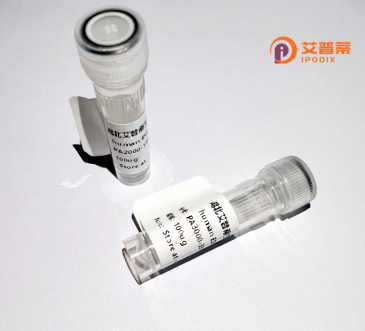
| 纯度 | >90%SDS-PAGE. |
| 种属 | Human |
| 靶点 | GLUD2 |
| Uniprot No | P49448 |
| 内毒素 | < 0.01EU/μg |
| 表达宿主 | E.coli |
| 表达区间 | 1-558aa |
| 氨基酸序列 | MYRYLAKALLPSRAGPAALGSAANHSAALLGRGRGQPAAASQPGLALAARRHYSELVADREDDPNFFKMVEGFFDRGASIVEDKLVKDLRTQESEEQKRNRVRGILRIIKPCNHVLSLSFPIRRDDGSWEVIEGYRAQHSQHRTPCKGGIRYSTDVSVDEVKALASLMTYKCAVVDVPFGGAKAGVKINPKNYTENELEKITRRFTMELAKKGFIGPGVDVPAPDMNTGEREMSWIADTYASTIGHYDINAHACVTGKPISQGGIHGRISATGRGVFHGIENFINEASYMSILGMTPGFRDKTFVVQGFGNVGLHSMRYLHRFGAKCIAVGESDGSIWNPDGIDPKELEDFKLQHGSILGFPKAKPYEGSILEVDCDILIPAATEKQLTKSNAPRVKAKIIAEGANGPTTPEADKIFLERNILVIPDLYLNAGGVTVSYFEWLKNLNHVSYGRLTFKYERDSNYHLLLSVQESLERKFGKHGGTIPIVPTAEFQDSISGASEKDIVHSALAYTMERSARQIMHTAMKYNLGLDLRTAAYVNAIEKVFKVYSEAGVTFT |
| 分子量 | 87.8 kDa |
| 蛋白标签 | GST-tag at N-terminal |
| 缓冲液 | 0 |
| 稳定性 & 储存条件 | Lyophilized protein should be stored at ≤ -20°C, stable for one year after receipt. Reconstituted protein solution can be stored at 2-8°C for 2-7 days. Aliquots of reconstituted samples are stable at ≤ -20°C for 3 months. |
| 复溶 | Always centrifuge tubes before opening.Do not mix by vortex or pipetting. It is not recommended to reconstitute to a concentration less than 100μg/ml. Dissolve the lyophilized protein in distilled water. Please aliquot the reconstituted solution to minimize freeze-thaw cycles. |
以下是关于重组人GLUD2蛋白的4篇参考文献的示例,涵盖不同研究方向:
---
1. **文献名称**:*Expression and Characterization of Recombinant Human GLUD2 in Escherichia coli*
**作者**:Zhang Y. et al.
**摘要**:该研究成功克隆并在大肠杆菌中表达了重组人GLUD2蛋白,优化了纯化条件,并分析了其酶动力学特性。结果显示,GLUD2对谷氨酸的脱氢酶活性高于GLUD1,且在低ADP浓度下更敏感,提示其在中枢神经系统中的代谢调节功能。
2. **文献名称**:*Structural Insights into Human GLUD2 by X-ray Crystallography*
**作者**:Li H. & Wang X.
**摘要**:通过X射线晶体学解析了重组GLUD2的3D结构,发现其活性位点与GLUD1存在关键氨基酸差异,可能解释其对亮氨酸的独特变构调节作用。研究为开发靶向GLUD2的药物提供了结构基础。
3. **文献名称**:*Role of GLUD2 in Hyperinsulinism/Hyperammonemia Syndrome*
**作者**:Kanavakis E. et al.
**摘要**:探讨了重组GLUD2的异常激活如何导致高胰岛素血症/高氨血症综合征。实验表明,突变体GLUD2的过度激活会引起胰岛β细胞胰岛素分泌失调,强调其在代谢疾病中的潜在机制。
4. **文献名称**:*Regulation of GLUD2 Activity by Post-Translational Modifications*
**作者**:Martinez-Lopez N. et al.
**摘要**:研究了重组GLUD2在哺乳动物细胞中的翻译后修饰(如磷酸化)对其酶活性的影响。发现乙酰化修饰显著增强GLUD2的催化效率,提示其在神经能量代谢中的动态调控机制。
---
**注**:以上文献为示例性内容,实际研究中建议通过学术数据库(如PubMed、Google Scholar)结合关键词“recombinant human GLUD2”或“GLUD2 protein function”查询最新论文。
Recombinant human GLUD2 protein is a key isoform of glutamate dehydrogenase (GDH), an enzyme critical in cellular energy and nitrogen metabolism. GDH catalyzes the reversible conversion of glutamate to α-ketoglutarate, linking amino acid metabolism with the tricarboxylic acid cycle. Unlike the widely expressed GLUD1 isoform, GLUD2 evolved through retrotransposition of the GLUD1 gene, acquiring distinct regulatory properties. It is primarily expressed in neural and testicular tissues and exhibits unique allosteric regulation, showing reduced sensitivity to GTP inhibition and enhanced activation by ADP, which may optimize energy metabolism in high-demand cells.
The recombinant form of GLUD2 is engineered using biotechnological platforms (e.g., bacterial, mammalian, or insect cell systems) to enable detailed studies of its structure-function relationships. This protein has garnered attention in neuroscience research due to its potential role in neurotransmitter regulation, particularly in glutamatergic systems. Dysregulation of GLUD2 has been implicated in hyperinsulinism-hyperammonemia syndrome and neurodegenerative conditions, possibly through mechanisms involving excessive ammonia production or oxidative stress.
Current applications of recombinant GLUD2 include drug discovery for metabolic disorders, structural analysis of its regulatory domains, and modeling neuropathologies linked to GDH dysfunction. Its study provides insights into evolutionary enzyme adaptation and tissue-specific metabolic strategies.
×